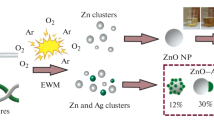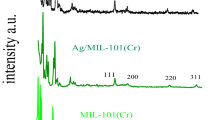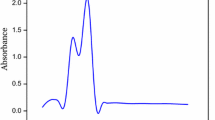Abstract
Galvanic replacement reaction was used in the synthesis of bimetallic gold–silver alloy nanoparticles (Au–Ag NPs), where pre-synthesized Ag nanoparticles-polyvinylpyrrolidone (AgNPs-PVP) were used to reduce the aryldiazonium tetrachloroaurate(III) salt in water. TEM images and EDS elemental analysis showed the formation of spherical Au–Ag NPs with sizes of 12.8 ± 4.9 nm and 25.6 ± 14.4 nm for corresponding Au–Ag ratios and termed as Au0.91Ag0.09 and Au0.79Ag0.21, respectively, with different concentrations of the gold precursor. The hydrodynamic sizes measured using dynamic light scattering are 46.4 nm and 74.8 nm with corresponding zeta potentials of − 44.56 and − 25.09 mV in water, for Au0.91Ag0.09 and Au0.79Ag0.21 respectively. Oxidative leachability of Ag ion studies from the starting AgNPs-PVP in 1 M NaCl showed a significant decrease in the plasmon peak after 8 h, indicating the complete dissolution of Ag ions, however, there is enhanced oxidation resistivity of Ag from Au–Ag NPs even after 24 h. Electrochemical studies on glassy carbon electrodes displayed a low oxidation peak in aqueous solutions of 20 mM KCl at 0.16 V and KNO3 at 0.33 V vs. saturated calomel electrode (SCE). We studied the antibacterial activity of Au–Ag alloy nanoparticles against gram-positive Staphylococcus aureus, Staphylococcus epidermidis, Enterococcus faecalis, and gram-negative Escherichia coli, Salmonella typhimurium, and Pseudomonas aeruginosa. Our findings demonstrated superior antibacterial activity of Au–Ag NPs compared with AgNPs-PVP. Moreover, the nanoparticles inhibited the S. epidermidis biofilm formation.
Graphical abstract








Similar content being viewed by others
Data availability
The data used to support the findings of this study are included within the article.
References
Ahmad AAL, Panicker S, Chehimi MM, Monge M, Lopez-De-Luzuriaga JM, Mohamed AA, Bruce AE, Bruce MRM (2019) Synthesis of water-soluble gold-aryl nanoparticles with distinct catalytic performance in the reduction of the environmental pollutant 4-nitrophenol. Catal Sci Technol 9:6059–6071. https://doi.org/10.1039/c9cy01402k
Al-Zubeidi A, Stein F, Flatebo C, Rehbock C, Hosseini Jebeli SA, Landes CF, Barcikowski S, Link S (2021) Single-particle hyperspectral imaging reveals kinetics of silver ion leaching from alloy nanoparticles. ACS Nano 15:8363–8375
Au L, Lu X, **a Y (2008) A comparative study of galvanic replacement reactions involving Ag nanocubes and AuCl2− or AuCl4−. Adv Mater 20:2517–2522
Bai T, Tan Y, Zou J, Nie M, Guo Z, Lu X, Gu N (2015) AuBr 2–-engaged galvanic replacement for citrate-capped Au–Ag alloy nanostructures and their solution-based surface-enhanced raman scattering activity. J Phys Chem C 119:28597–28604
Berahim N, Basirun WJ, Leo BF, Johan MR (2018) Synthesis of bimetallic gold-silver (Au-Ag) nanoparticles for the catalytic reduction of 4-nitrophenol to 4-aminophenol. Catalysts 8:412
Bhattacharya C, Arora N, Jagirdar BR (2018) Digestive-ripening-facilitated nanoengineering of diverse bimetallic nanostructures. Langmuir 35:6493–6505
Bijalwan K, Kainthola A, Sharma H, Dwivedi C (2020) Catalytic reduction of 4-nitrophenol using gold-silver alloy nanoparticles coated on alkali activated sand. Mater Today Proc 28:1097–1100
Borah R, Verbruggen SW (2020) Silver-gold bimetallic alloy versus core-shell nanoparticles: implications for plasmonic enhancement and photothermal applications. J Phys Chem C 124:12081–12094
Botros NS (2015) Gold in Egypt: does the future get worse or better? Ore Geol Rev 67:189–207
Chen L, Deming CP, Peng Y, Hu P, Stofan J, Chen S (2016) Gold core@ silver semishell Janus nanoparticles prepared by interfacial etching. Nanoscale 8:14565–14572
Chernousova S, Epple M (2013) Silver as antibacterial agent: ion, nanoparticle, and metal. Angew Chemie Int Ed 52:1636–1653
Cunningham JC, Kogan MR, Tsai Y-J, Luo L, Richards I, Crooks RM (2016) based sensor for electrochemical detection of silver nanoparticle labels by galvanic exchange. ACS Sens 1:40–47
Das S, Debnath N, Mitra S, Datta A, Goswami A (2012) Comparative analysis of stability and toxicity profile of three differently capped gold nanoparticles for biomedical usage. Biometals 25:1009–1022
Dolinska J, Holdynski M, Ambroziak R, Modrzejewska-Sikorska A, Milczarek G, Pisarek M, Opallo M (2020) The medium effect on electrodissolution of adsorbed or suspended Ag nanoparticles. Electrochim Acta 350:136406
Dong Y, Zhu H, Shen Y, Zhang W, Zhang L (2019) Antibacterial activity of silver nanoparticles of different particle size against Vibrio Natriegens. PLoS ONE 14:e0222322
Ferrando R, Jellinek J, Johnston RL (2008) Nanoalloys: from theory to applications of alloy clusters and nanoparticles. Chem Rev 108:845–910
Gilroy KD, Hughes RA, Neretina S (2014) Kinetically controlled nucleation of silver on surfactant-free gold seeds. J Am Chem Soc 136:15337–15345
Gilroy KD, Ruditskiy A, Peng H-C, Qin D, **a Y (2016) Bimetallic nanocrystals: syntheses, properties, and applications. Chem Rev 116:10414–10472
González E, Arbiol J, Puntes VF (2011) Carving at the nanoscale: sequential galvanic exchange and Kirkendall growth at room temperature. Science 334:1377–1380
Hahn A, Fuhlrott J, Loos A, Barcikowski S (2012) Cytotoxicity and ion release of alloy nanoparticles. J Nanoparticle Res 14:1–10
Han C, Likodimos V, Khan JA, Nadagouda MN, Andersen J, Falaras P, Rosales-Lombardi P, Dionysiou DD (2014) UV–visible light-activated Ag-decorated, monodisperse TiO2 aggregates for treatment of the pharmaceutical oxytetracycline. Environ Sci Pollut Res 21:11781–11793
Han C, Nagendra V, Baig RB, Varma RS, Nadagouda MN (2015) Expeditious synthesis of noble metal nanoparticles using vitamin B12 under microwave irradiation. Appl Sci 5:415–426
Holt LR, Plowman BJ, Young NP, Tschulik K, Compton RG (2016) The electrochemical characterization of single core–shell nanoparticles. Angew Chem Int Ed 55:397–400
Ivask A, ElBadawy A, Kaweeteerawat C, Boren D, Fischer H, Ji Z, Chang CH, Liu R, Tolaymat T, Telesca D (2014) Toxicity mechanisms in Escherichia coli vary for silver nanoparticles and differ from ionic silver. ACS Nano 8:374–386
Jang H, Min D-H (2015) Spherically-clustered porous Au–Ag alloy nanoparticle prepared by partial inhibition of galvanic replacement and its application for efficient multimodal therapy. ACS Nano 9:2696–2703
Jena P, Bhattacharya M, Bhattacharjee G, Satpati B, Mukherjee P, Senapati D, Srinivasan R (2020) Bimetallic gold–silver nanoparticles mediate bacterial killing by disrupting the actin cytoskeleton MreB. Nanoscale 12:3731–3749
Kittler S, Greulich C, Diendorf J, Koller M, Epple M (2010) Toxicity of silver nanoparticles increases during storage because of slow dissolution under release of silver ions. Chem Mater 22:4548–4554
Kwon YJ, Son DH, Ahn SJ, Kim MS, Kim K (1994) Vibrational spectroscopic investigation of benzoic acid adsorbed on silver. J Phys Chem 98:8481–8487
Li X, Chen Q, McCue I, Snyder J, Crozier P, Erlebacher J, Sieradzki K (2014) Dealloying of noble-metal alloy nanoparticles. Nano Lett 14:2569–2577
Link S, Wang ZL, El-Sayed MA (1999) Alloy formation of gold−silver nanoparticles and the dependence of the plasmon absorption on their composition. J Phys Chem B 103:3529–3533
Liu J, Sonshine DA, Shervani S, Hurt RH (2010) Controlled release of biologically active silver from nanosilver surfaces. ACS Nano 4:6903–6913
Liu T, Song X, Guo Z, Dong Y, Guo N, Chang X (2014) Prolonged antibacterial effect of silver nanocomposites with different structures. Colloids Surf B 116:793–796
Liu R, Guo J, Ma G, Jiang P, Zhang D, Li D, Chen L, Guo Y, Ge G (2016) Alloyed crystalline Au–Ag hollow nanostructures with high chemical stability and catalytic performance. ACS Appl Mater Interfaces 8:16833–16844
Long Y-M, Hu L-G, Yan X-T, Zhao X-C, Zhou QF, Cai Y, Jiang GB (2017) Surface ligand controls silver ion release of nanosilver and its antibacterial activity against Escherichia coli. Int J Nanomed 12:3193
Loza K, Heggen M, Epple M (2020) Synthesis, structure, properties, and applications of bimetallic nanoparticles of noble metals. Adv Funct Mater 30:1909260
Ma R, Levard C, Marinakos SM, Cheng Y, Liu J, Michel FM, Brown GE Jr, Lowry GV (2012) Size-controlled dissolution of organic-coated silver nanoparticles. Environ Sci Technol 46:752–759
Mao H, Feng J, Ma X, Wu C, Zhao X (2012) One-dimensional silver nanowires synthesized by self-seeding polyol process. J Nanoparticle Res 14:1–15
Martínez LL, Segarra M, Fernandez M, Espiell F (1993) Kinetics of the dissolution of pure silver and silver-gold alloys in nitric acid solution. Metall Trans B 24:827–837
Mijnendonckx K, Leys N, Mahillon J, Silver S, Van Houdt R (2013) Antimicrobial silver: uses, toxicity and potential for resistance. Biometals 26:609–621
Mohamed AA, Bruce AE, Bruce MRM (1999) Cyclic voltammetry of Auranofin. Met-Based Drugs 6:233–238
Mohamed AA, Bauer JAK, Bruce AE, Bruce MRM (2003) [μ-o-Phenylenebis (diphenylphosphine)-κ2P: P′] bis [chlorogold (I)], dppbz (AuCl)2. Acta Crystallogr C 59:m84–m86
Murzyn A, Krasowska A, Stefanowicz P, Dziadkowiec D, Łukaszewicz M (2010) Capric acid secreted by S. boulardii inhibits C. albicans filamentous growth, adhesion and biofilm formation. PLoS ONE 5(8):12050
Nishimura S, Dao ATN, Mott D, Ebitani K, Maenosono S (2012) X-ray absorption near-edge structure and X-ray photoelectron spectroscopy studies of interfacial charge transfer in gold–silver–gold double-shell nanoparticles. J Phys Chem C 116:4511–4516
Padmos JD, Langman M, MacDonald K, Comeau P, Yang Z, Filiaggi M, Zhang P (2015) Correlating the atomic structure of bimetallic silver–gold nanoparticles to their antibacterial and cytotoxic activities. J Phys Chem C 119:7472–7482
Pagannone M, Fornari B, Mattei G (1987) Molecular structure and orientation of chemisorbed aromatic carboxylic acids: surface enhanced Raman spectrum of benzoic acid adsorbed on silver sol. Spectrochim Acta Part A 43:621–625
Pallavicini P, Taglietti A, Dacarro G, Diaz-Fernandez YA, Galli M, Grisoli P, Patrini M, De Magistris GS, Zanoni R (2010) Self-assembled monolayers of silver nanoparticles firmly grafted on glass surfaces: Low Ag+ release for an efficient antibacterial activity. J Colloid Interface Sci 350:110–116
Panicker S, Ahmady IM, Han C, Chehimi M, Mohamed AA (2020) On demand release of ionic silver from gold-silver alloy nanoparticles: fundamental antibacterial mechanisms study. Mater Today Chem 16:100237. https://doi.org/10.1016/j.mtchem.2019.100237
Pattadar DK, Sharma JN, Mainali BP, Zamborini FP (2019) Impact of the assembly method on the surface area-to-volume ratio and electrochemical oxidation potential of metal nanospheres. J Phys Chem C 123:24304–24312
Peretyazhko TS, Zhang Q, Colvin VL (2014) Size-controlled dissolution of silver nanoparticles at neutral and acidic pH conditions: kinetics and size changes. Environ Sci Technol 48:11954–11961
Plowman BJ, Sidhureddy B, Sokolov SV, Young NP, Chen A, Compton RG (2016) Electrochemical behavior of gold–silver alloy nanoparticles. ChemElectroChem 3:1039–1043
Ramasamy M, Lee J-H, Lee J (2016) Potent antimicrobial and antibiofilm activities of bacteriogenically synthesized gold–silver nanoparticles against pathogenic bacteria and their physiochemical characterizations. J Biomater Appl 31:366–378
Ray P, Clément M, Martini C, Abdellah I, Beaunier P, Rodriguez-Lopez JL, Huc V, Remita H, Lampre I (2018) Stabilisation of small mono-and bimetallic gold–silver nanoparticles using calix [8] arene derivatives. New J Chem 42:14128–14137
Rioux D, Meunier M (2015) Seeded growth synthesis of composition and size-controlled gold–silver alloy nanoparticles. J Phys Chem C 119:13160–13168
Russo L, Puntes V, Merkoçi A (2018) Tunable electrochemistry of gold-silver alloy nanoshells. Nano Res 11:6336–6345
Saw EN, Grasmik V, Rurainsky C, Epple M, Tschulik K (2016) Electrochemistry at single bimetallic nanoparticles–using nano impacts for sizing and compositional analysis of individual AgAu alloy nanoparticles. Faraday Discuss 193:327–338
Shibata T, Bunker BA, Zhang Z, Meisel D, Vardeman CF, Gezelter JD (2002) Size-dependent spontaneous alloying of Au− Ag nanoparticles. J Am Chem Soc 124:11989–11996
Shirman T, Lattimer J, Luneau M et al (2018) New architectures for designed catalysts: selective oxidation using agau nanoparticles on colloid-templated silica. Chem Eur J 24:1833–1837
Sun Y, Wang Y (2011) Monitoring of galvanic replacement reaction between silver nanowires and HAuCl4 by in situ transmission X-ray microscopy. Nano Lett 11:4386–4392
Sun Y, **a Y (2004) Mechanistic study on the replacement reaction between silver nanostructures and chloroauric acid in aqueous medium. J Am Chem Soc 126:3892–3901
Sun Y, Mayers BT, **a Y (2002) Template-engaged replacement reaction: a one-step approach to the large-scale synthesis of metal nanostructures with hollow interiors. Nano Lett 2:481–485
Tanner EEL, Sokolov SV, Young NP, Batchelor-McAule C, Compton RG (2017a) Fluorescence electrochemical microscopy: cap** agent effects with ethidium bromide/DNA capped silver nanoparticles. Angew Chem 129:12925–12928
Tanner EEL, Sokolov SV, Young NP, Compton RG (2017b) DNA cap** agent control of electron transfer from silver nanoparticles. Phys Chem Chem Phys 19:9733–9738
Toh HS, Jurkschat K, Compton RG (2015) The Influence of the cap** agent on the oxidation of silver nanoparticles: nano-impacts versus strip** voltammetry. Chem Eur J 21:2998–3004
Wan D, **a X, Wang Y, **a Y (2013) Robust synthesis of gold cubic nanoframes through a combination of galvanic replacement, gold deposition, and silver dealloying. Small 9:3111–3117
Wang S, Li Q, Kang X, Zhu M (2018) Customizing the structure, composition, and properties of alloy nanoclusters by metal exchange. Acc Chem Res 51:2784–2792
Wikler MA (2006) Methods for dilution antimicrobial susceptibility tests for bacteria that grow aerobically: approved standard. CLSI 26:M7-A7
Wu T, Ma J, Wang X, Liu Y, Xu H, Gao J, Wang W, Liu Y, Yan J (2013) Graphene oxide supported Au–Ag alloy nanoparticles with different shapes and their high catalytic activities. Nanotechnology 24:125301
**e R-C, Batchelor-McAuley C, Yang M, Compton RG (2021) Substrate mediated dissolution of redox active nanoparticles; electron transfer over long distances. Nano Res 1–9
**e R-C, Batchelor-McAuley C, Yang M, Compton RG (2022) Substrate mediated dissolution of redox active nanoparticles; electron transfer over long distances. Nano Res 15:429–437
Xu Z, Zhang C, Wang X, Liu D (2021) Release strategies of silver ions from materials for bacterial killing. ACS Appl Bio Mater 4:3985–3999
Yang L, Yan W, Wang H, Zhuang H, Zhang J (2017) Shell thickness-dependent antibacterial activity and biocompatibility of gold@ silver core–shell nanoparticles. RSC Adv 7:11355–11361
Yu KH, Rhee JM, Lee Y, Lee K, Yu SC (2001) Surface-enhanced Raman scattering study of 4-biphenylcarboxylic acid. Langmuir 17:52–55
Zhang W, Yao Y, Sullivan N, Chen Y (2011) Modeling the primary size effects of citrate-coated silver nanoparticles on their ion release kinetics. Environ Sci Technol 45:4422–4428
Zheng K, **e J (2020) Composition-dependent antimicrobial ability of full-spectrum Au x Ag25–x alloy nanoclusters. ACS Nano 14:11533–11541
Zhou M, Li C, Fang J (2020) Noble-metal based random alloy and intermetallic nanocrystals: syntheses and applications. Chem Rev
Zugic B, Wang L, Heine C, Zakharov DN, Lechner BAJ, Stach EA, Biener J, Salmeron M, Madix RJ, Friend CM (2017) Dynamic restructuring drives catalytic activity on nanoporous gold–silver alloy catalysts. Nat Mater 16:558–564
Acknowledgements
AAM acknowledges the University of Sharjah support of competitive grants 160-2142-029-P and 150-2142-017-P. CH acknowledges the support of the National Research Foundation of Korea (NRF) grant funded by the Korean government (MSIT) (No. 2021R1A4A1032746) and (No. 2021R1A2C1093183).
Author information
Authors and Affiliations
Corresponding author
Ethics declarations
Competing interest
The authors declare that they have no known competing financial interests or personal relationships that could have appeared to influence the work reported in this paper.
Additional information
Publisher's Note
Springer Nature remains neutral with regard to jurisdictional claims in published maps and institutional affiliations.
Supplementary Information
Below is the link to the electronic supplementary material.
Rights and permissions
Springer Nature or its licensor holds exclusive rights to this article under a publishing agreement with the author(s) or other rightsholder(s); author self-archiving of the accepted manuscript version of this article is solely governed by the terms of such publishing agreement and applicable law.
About this article
Cite this article
Parambath, J.B.M., Ahmady, I.M., Panicker, S. et al. Correlation notice on the electrochemical dealloying and antibacterial properties of gold–silver alloy nanoparticles. Biometals 35, 1307–1323 (2022). https://doi.org/10.1007/s10534-022-00446-w
Received:
Accepted:
Published:
Issue Date:
DOI: https://doi.org/10.1007/s10534-022-00446-w




